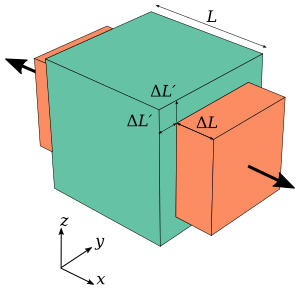Poisson's ratio facts for kids
Poisson's ratio (pronounced PWAH-sawnz RAY-shee-oh) is a special number that tells us how much an object changes shape when you stretch or squeeze it. Imagine pulling on a rubber band. It gets longer, right? But it also gets thinner in the middle. Poisson's ratio helps us measure how much thinner it gets compared to how much longer it gets.
This number helps scientists and engineers understand how different materials will behave. It's important for designing things like bridges, buildings, and even sports equipment.
What Is Poisson's Ratio?
When you pull on a material, it stretches in the direction you are pulling. This is called axial stretching. At the same time, the material often gets narrower or thinner in the directions sideways to your pull. This is called transverse contraction.
Poisson's ratio is a way to compare these two changes. It's the ratio of how much it shrinks sideways to how much it stretches lengthwise.
How Materials Behave
Different materials have different Poisson's ratios. This means they behave in unique ways when stretched or squeezed.
- Materials with a low Poisson's ratio: Think of cork. If you pull on a piece of cork, it gets longer, but it doesn't get much thinner. Its Poisson's ratio is very close to zero. This is why cork is good for stoppers – it doesn't change much in width when pushed into a bottle.
- Materials with a high Poisson's ratio: Rubber is a good example. When you stretch a rubber band, it gets much thinner. Rubber has a high Poisson's ratio, around 0.5.
- Materials with a negative Poisson's ratio: These are very unusual and cool materials! If you pull on them, they actually get wider instead of narrower. Imagine pulling a net, and the holes in the net get bigger. These materials are sometimes called "auxetic" materials. They are being studied for special uses, like in body armor or medical devices.
Most common materials have a Poisson's ratio between 0.0 and 0.5.
Images for kids
See also
 In Spanish: Coeficiente de Poisson para niños
In Spanish: Coeficiente de Poisson para niños



